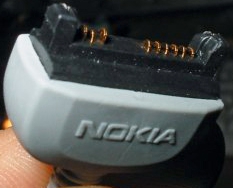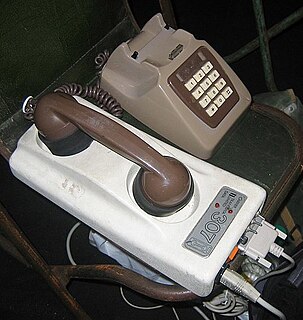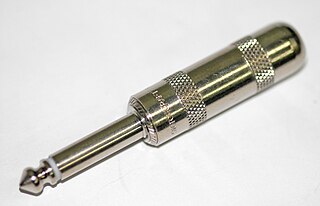
A phone connector, also known as phone jack, audio jack, headphone jack or jack plug, is a family of electrical connectors typically used for analog audio signals.
A DC connector is an electrical connector for supplying direct current (DC) power.

USB On-The-Go, often abbreviated to USB OTG or just OTG, is a specification first used in late 2001 that allows USB devices, such as tablets or smartphones, to act as a host, allowing other USB devices, such as USB flash drives, digital cameras, mice or keyboards, to be attached to them. Use of USB OTG allows those devices to switch back and forth between the roles of host and device. A mobile phone may read from removable media as the host device, but present itself as a USB Mass Storage Device when connected to a host computer.

A hot shoe is a mounting point on the top of a camera to attach a flash unit and other compatible accessories. It takes the form of an angled metal bracket surrounding a metal contact point which shorts an electrical connection between camera and accessory for standard, brand-independent flash synchronization.
LANC, also known as Control-L is a hardware and software communication protocol invented by Sony that synchronizes cameras.
Various accessories for the PlayStation 3 video game console have been produced by Sony. These include controllers, audio and video input devices like microphones, video cameras, and cables for better sound and picture quality.
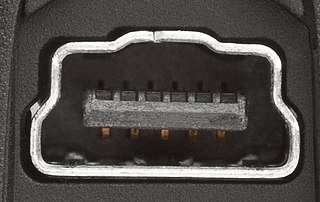
An enhanced mini-USB (EMU) connector is a type of hybrid electrical connector which carries Universal Serial Bus data and power as well as other connections such as bidirectional audio. It was invented for and is mainly used on mobile phones. Motorola, HTC Corporation, and other mobile phone manufacturers use EMU connectors. There is more than one standard for EMU connectors, which are incompatible between manufacturers, but all are physically and electrically compatible with standard mini-USB connectors. The EMU connector has five pins for USB on one side. While regular USB connectors are empty on the other side, EMU has more pins intended for headsets. In HTC's version, two pins are for the microphone, three are for stereo sound, and one is for the push-to-talk switch.

A headset combines a headphone with a microphone. Headsets are made with either a single-earpiece (mono) or a double-earpiece. Headsets provide the equivalent functionality of a telephone handset but with handsfree operation. They have many uses including in call centers and other telephone-intensive jobs and for anybody wishing to have both hands free during a telephone conversation.
Mobile High-Definition Link (MHL) is an industry standard for a mobile audio/video interface that allows the connection of smartphones, tablets, and other portable consumer electronics devices to high-definition televisions (HDTVs), audio receivers, and projectors. The standard was designed to share existing mobile device connectors, such as Micro-USB, and avoid the need to add additional video connectors on devices with limited space for them.
A dock connector is a connector used to attach a mobile electronic device simultaneously to multiple external resources. The dock connector will typically carry a variety of signals and power, through a single connector, to simplify the process of docking the mobile device. A dock connector may be embedded in a mechanical fixture used to support or align the mobile device or may be at the end of a cable.
Audio connectors and video connectors are electrical or optical connectors for carrying audio and video signals. Audio interfaces and video interfaces define physical parameters and interpretation of signals. For digital audio and digital video, this can be thought of as defining the physical layer, data link layer, and most or all of the application layer. For analog audio and analog video these functions are all represented in a single signal specification like NTSC or the direct speaker-driving signal of analog audio. Physical characteristics of the electrical or optical equipment includes the types and numbers of wires required, voltages, frequencies, optical intensity, and the physical design of the connectors. Any data link layer details define how application data is encapsulated. Application layer details define the actual audio or video format being transmitted, often incorporating a codecs not specific to the interface, such as PCM, MPEG-2, or the DTS Coherent Acoustics codec. In some cases, the application layer is left open; for example, HDMI contains an Ethernet channel for general data transmission.

Sony Ericsson W205 is an entry-level dual-band GSM/GPRS Walkman phone with a focus on music playback. It was announced on 7 April 2009 under the marketing tag ‘your first Walkman phone’.
In 2009 a European Commission initiative resulted in the specification of a common external power supply for use with data-enabled mobile phones sold in the European Union. The external power supply is the AC power adapter that converts household AC electricity voltages to the much lower DC voltages needed to charge a mobile phone's internal battery. Although compliance is voluntary, a majority of the world's largest mobile phone manufacturers agreed to make their applicable mobile phones compatible with Europe's common external power supply specifications.

Lightning is a proprietary computer bus and power connector created by Apple Inc. Introduced on September 12, 2012, to replace its predecessor, the 30-pin dock connector, the Lightning connector is used to connect Apple mobile devices like iPhones, iPads, and iPods to host computers, external monitors, cameras, USB battery chargers, and other peripherals. Using 8 pins instead of 30, Lightning is significantly more compact than the 30-pin dock connector and can be inserted with either side facing up. However, unless used with an adapter, it is incompatible with cables and peripherals designed for its predecessor.
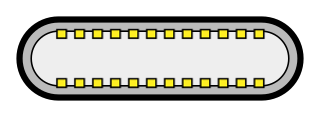
USB-C, formally known as USB Type-C, is a 24-pin USB connector system, which is distinguished by its two-fold rotationally-symmetrical connector.
This article provides information about the physical aspects of Universal Serial Bus, USB: connectors, cabling, and power. The initial versions of the USB standard specified connectors that were easy to use and that would have acceptable life spans; revisions of the standard added smaller connectors useful for compact portable devices. Higher-speed development of the USB standard gave rise to another family of connectors to permit additional data paths. All versions of USB specify cable properties; version 3.X cables include additional data paths. The USB standard included power supply to peripheral devices; modern versions of the standard extend the power delivery limits for battery charging and devices requiring up to 100 watts. USB has been selected as the standard charging format for many mobile phones, reducing the proliferation of proprietary chargers.

